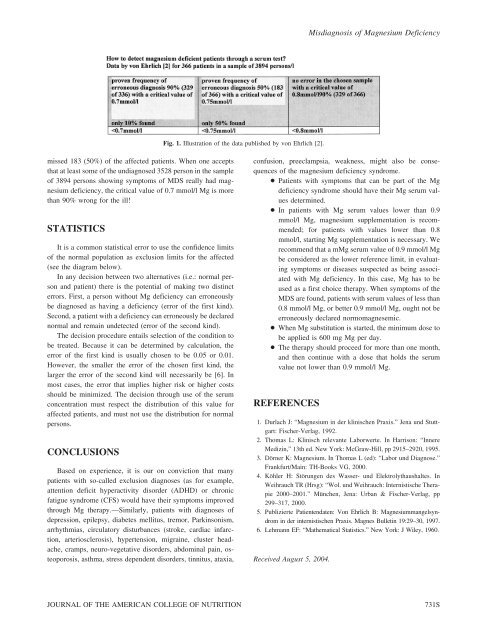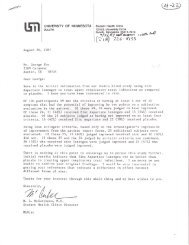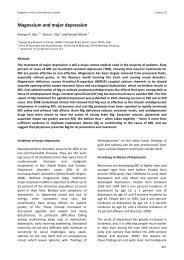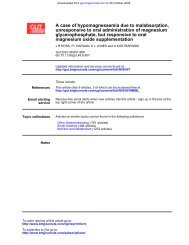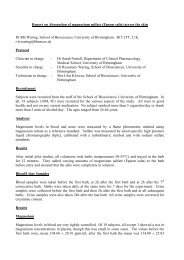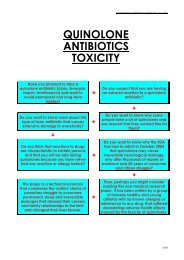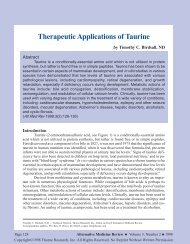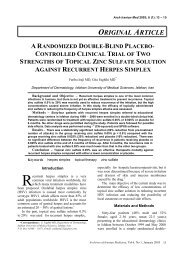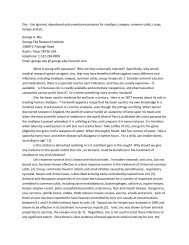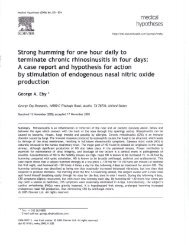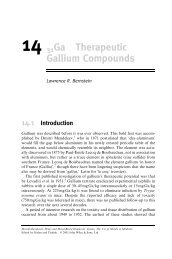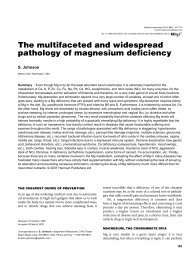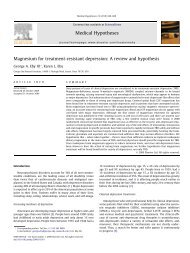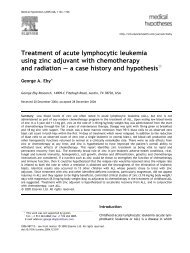About the Misdiagnosis of Magnesium Deficiency - George Eby ...
About the Misdiagnosis of Magnesium Deficiency - George Eby ...
About the Misdiagnosis of Magnesium Deficiency - George Eby ...
Create successful ePaper yourself
Turn your PDF publications into a flip-book with our unique Google optimized e-Paper software.
missed 183 (50%) <strong>of</strong> <strong>the</strong> affected patients. When one accepts<br />
that at least some <strong>of</strong> <strong>the</strong> undiagnosed 3528 person in <strong>the</strong> sample<br />
<strong>of</strong> 3894 persons showing symptoms <strong>of</strong> MDS really had magnesium<br />
deficiency, <strong>the</strong> critical value <strong>of</strong> 0.7 mmol/l Mg is more<br />
than 90% wrong for <strong>the</strong> ill!<br />
STATISTICS<br />
It is a common statistical error to use <strong>the</strong> confidence limits<br />
<strong>of</strong> <strong>the</strong> normal population as exclusion limits for <strong>the</strong> affected<br />
(see <strong>the</strong> diagram below).<br />
In any decision between two alternatives (i.e.: normal person<br />
and patient) <strong>the</strong>re is <strong>the</strong> potential <strong>of</strong> making two distinct<br />
errors. First, a person without Mg deficiency can erroneously<br />
be diagnosed as having a deficiency (error <strong>of</strong> <strong>the</strong> first kind).<br />
Second, a patient with a deficiency can erroneously be declared<br />
normal and remain undetected (error <strong>of</strong> <strong>the</strong> second kind).<br />
The decision procedure entails selection <strong>of</strong> <strong>the</strong> condition to<br />
be treated. Because it can be determined by calculation, <strong>the</strong><br />
error <strong>of</strong> <strong>the</strong> first kind is usually chosen to be 0.05 or 0.01.<br />
However, <strong>the</strong> smaller <strong>the</strong> error <strong>of</strong> <strong>the</strong> chosen first kind, <strong>the</strong><br />
larger <strong>the</strong> error <strong>of</strong> <strong>the</strong> second kind will necessarily be [6]. In<br />
most cases, <strong>the</strong> error that implies higher risk or higher costs<br />
should be minimized. The decision through use <strong>of</strong> <strong>the</strong> serum<br />
concentration must respect <strong>the</strong> distribution <strong>of</strong> this value for<br />
affected patients, and must not use <strong>the</strong> distribution for normal<br />
persons.<br />
CONCLUSIONS<br />
Based on experience, it is our on conviction that many<br />
patients with so-called exclusion diagnoses (as for example,<br />
attention deficit hyperactivity disorder (ADHD) or chronic<br />
fatigue syndrome (CFS) would have <strong>the</strong>ir symptoms improved<br />
through Mg <strong>the</strong>rapy.—Similarly, patients with diagnoses <strong>of</strong><br />
depression, epilepsy, diabetes mellitus, tremor, Parkinsonism,<br />
arrhythmias, circulatory disturbances (stroke, cardiac infarction,<br />
arteriosclerosis), hypertension, migraine, cluster headache,<br />
cramps, neuro-vegetative disorders, abdominal pain, osteoporosis,<br />
asthma, stress dependent disorders, tinnitus, ataxia,<br />
Fig. 1. Illustration <strong>of</strong> <strong>the</strong> data published by von Ehrlich [2].<br />
confusion, preeclampsia, weakness, might also be consequences<br />
<strong>of</strong> <strong>the</strong> magnesium deficiency syndrome.<br />
● Patients with symptoms that can be part <strong>of</strong> <strong>the</strong> Mg<br />
deficiency syndrome should have <strong>the</strong>ir Mg serum values<br />
determined.<br />
● In patients with Mg serum values lower than 0.9<br />
mmol/l Mg, magnesium supplementation is recommended;<br />
for patients with values lower than 0.8<br />
mmol/l, starting Mg supplementation is necessary. We<br />
recommend that a mMg serum value <strong>of</strong> 0.9 mmol/l Mg<br />
be considered as <strong>the</strong> lower reference limit, in evaluating<br />
symptoms or diseases suspected as being associated<br />
with Mg deficiency. In this case, Mg has to be<br />
used as a first choice <strong>the</strong>rapy. When symptoms <strong>of</strong> <strong>the</strong><br />
MDS are found, patients with serum values <strong>of</strong> less than<br />
0.8 mmol/l Mg, or better 0.9 mmol/l Mg, ought not be<br />
erroneously declared normomagnesemic.<br />
● When Mg substitution is started, <strong>the</strong> minimum dose to<br />
be applied is 600 mg Mg per day.<br />
● The <strong>the</strong>rapy should proceed for more than one month,<br />
and <strong>the</strong>n continue with a dose that holds <strong>the</strong> serum<br />
value not lower than 0.9 mmol/l Mg.<br />
REFERENCES<br />
1. Durlach J: “<strong>Magnesium</strong> in der klinischen Praxis.” Jena und Stuttgart:<br />
Fischer-Verlag, 1992.<br />
2. Thomas L: Klinisch relevante Laborwerte. In Harrison: “Innere<br />
Medizin,” 13th ed. New York: McGraw-Hill, pp 2915–2920, 1995.<br />
3. Dörner K: <strong>Magnesium</strong>. In Thomas L (ed): “Labor und Diagnose.”<br />
Frankfurt/Main: TH-Books VG, 2000.<br />
4. Köhler H: Störungen des Wasser- und Elektrolythaushaltes. In<br />
Weihrauch TR (Hrsg): “Wol. und Weihrauch: Internistische Therapie<br />
2000–2001.” München, Jena: Urban & Fischer-Verlag, pp<br />
299–317, 2000.<br />
5. Publizierte Patientendaten: Von Ehrlich B: <strong>Magnesium</strong>mangelsyndrom<br />
in der internistischen Praxis. Magnes Bulletin 19:29–30, 1997.<br />
6. Lehmann EF: “Ma<strong>the</strong>matical Statistics.” New York: J Wiley, 1960.<br />
Received August 5, 2004.<br />
<strong>Misdiagnosis</strong> <strong>of</strong> <strong>Magnesium</strong> <strong>Deficiency</strong><br />
JOURNAL OF THE AMERICAN COLLEGE OF NUTRITION 731S


